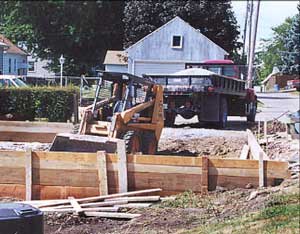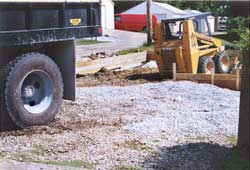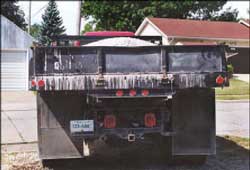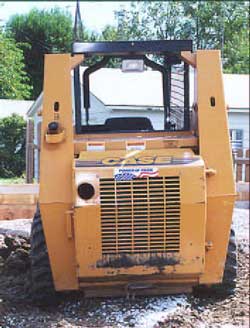

Man Crushed Between Skid-Steer Loader and Dump Truck
 |
|
Photo 1 – View from front of skid-steer
showing garage area and truck. |
RECOMMENDATIONS based on our investigation are as follows:
INTRODUCTION
During the fall of 2002, a 31-year-old concrete construction worker was killed while working on a residential garage. The Iowa FACE program was notified two months later by a report from the Iowa Medical Examiner’s office and began an investigation. Information and photographs were obtained from a company representative and local police, which included eyewitness statements from coworkers and others at the scene. It was determined that a site visit to the worksite would not be productive and sufficient information had been gathered for this report.
The employer is a family construction business, which at that time employed five individuals. They had been in this seasonal business for the past 12 years doing all types of concrete work in the area. The victim had grown up in the business and had worked there full-time for the past 11 years. Five men were working at the residential location on the day of the accident. It was their first day on this particular job.
There was no safety program or written policies in place at this small business. Family members were accustomed to working together and safety was viewed as a common sense issue. The victim was experienced in all aspects of the business, however operation of the skid-steer loader was reserved for one worker with the most experience.
INVESTIGATION
The concrete construction company was working to pour the foundation and floor for a new single-car garage in a residential neighborhood. It was their first day on this job and the crew was busy leveling and preparing the soil, setting forms, etc. One man was operating the skid-steer loader, moving dirt and gravel around the site with the back of the loader facing the street (vehicle access drive into the construction site). Other workers had just arrived driving a single axle dump truck carrying a fresh load of gravel (see Photo 2).
The truck had a back-up alarm, which was functioning, but the skid-loader operator apparently did not hear the alarm, and kept working. The dump truck was backed into position from the street and the victim and a co-worker were in process of locking down the tailgate to dump the gravel in a pile adjacent to the driveway area. The loader operator did not know the truck had returned or was in position to dump, for he was facing away from the dump truck. He continued to move gravel and dirt preparing the foundation on the opposite side of the construction site, assisted by another employee.
The victim, with his back to the loader, had just finished locking down the tailgate. His co-worker had finished doing the same on his side of the truck and had stepped to the side of the truck. At that time, while backing up, the skid-steer loader pinned the victim against the rear end of the dump truck causing fatal internal injuries. Only when he heard cries for help did the skid-steer loader operator realize he had backed into the victim, because the skid steer had not come into contact (collided) with the dump truck.
The victim staggered away from the truck, then fell to the ground clutching his abdomen. He quickly became unresponsive, and other workers and eyewitnesses in the area rushed to his aid. Someone dialed 911, and others administered CPR, for the victim had become pulseless. Rescue arrived within a few minutes and the victim was rushed to a local hospital, but resuscitation failed and he was declared dead.
The skid-steer loader was a Case Model 1840 diesel, about 4-5 years old. It was in normal operating condition and did not have a backup alarm or rear view mirror. In the future, workers with this company agreed to never work directly behind an operating skid-steer loader. Further, all of these workers showed an increased awareness of the potential danger these machines present, and now give such equipment a much larger operating area.
 |
 |
| Photo 2 – View from sidewalk showing gravel pile and rear of skid-steer loader. | Photo 3 – View of rear
of dump truck. |
CAUSE OF DEATH
The cause of death taken from the Iowa Medical Examiner’s report was, “exsanguination due to traumatic compression of the chest and abdomen due to industrial accident”. An autopsy was performed, which confirmed the severe internal injuries and bleeding.
RECOMMENDATIONS / DISCUSSION
Recommendation #1 Employee safety training and education must be an integral component of every business mission, regardless of size or number of employees.
Discussion: Safety is everyone’s responsibility in a workplace or construction site. A small family business, such as this construction company, shares many similarities with the majority of small businesses throughout the United States. Unfortunately, in most small operations safety is usually not addressed in an official manner, nor is employee safety training repeated, reviewed, or updated on a regular basis. Consequently, workers can become complacent over time and slowly develop unsafe work practices.
In larger construction zones, one worker may be assigned the responsibility to spot dangerous situations when machines are moving about or backing up. In this case, each worker present could have prevented this incident. The skid-steer operator could have looked more carefully behind him before backing up. His assistant could have alerted him of the arrival of the dump truck. The truck driver or the younger workers could have whistled or signaled to alert these men they were backing into the work zone with the dump truck. The victim and his co-worker could have exercised more caution working with their backs to the skid-steer. Safety training and communication may be difficult for smaller businesses like this one to initiate, but it is vital to establish safe work practices before tragic events occur. Certainly in the future, all workers in this concrete business will have a third eye looking for potentially dangerous situations between machines and workers.
Recommendation #2 Employers must insure that employees are aware of
hazards, limitations, or potentially dangerous conditions associated with using
specific equipment on the jobsite.
Discussion: Skid-steer loaders are designed to make quick movements in all directions, going backwards and forwards and turning every few seconds. Skilled operators can become extremely efficient with these machines, making quick work of soil preparation. Due to their design, skid-steer loaders have compromised vision to the rear with large blind spots at rear corners created by the lift arms, hydraulics, etc. (see Photo 4). Side mirrors are not practical, and rear-view mirrors would still retain the corner blind spots. All work crews using skid steers need renewed awareness of these visual limitations and operational characteristics, and move personnel and equipment to a safe distance, especially from the rear. Also, all skid-steer loader operators need to maintain control of these machines at all times (i.e. according to the manufacturer operator’s manual). Overall, these machines must be operated at safe speeds and be given appropriate operating space. Further, due to the inherent visual limitations of these machines to the rear, operators should always look behind before backing up, and drive forward for the best visibility whenever possible.
 |
| Photo 4 –
View of rear of skid-steer. |
Recommendation #3 Backup alarms with variable intensity and frequency should be installed on all skid-steer loaders, and owner / operators should ensure that mufflers are working properly to reduce machine noise
Discussion: The use of a backup alarm is an obvious recommendation, however, alarms can easily become ineffective if they are ignored by workers or if their intensity is below that of the background noise level at a jobsite. As mentioned earlier, skid-steer loaders change directions very quickly, and an alarm which is constantly going on and off will soon become an annoyance, which may lead to its removal by workers.
Virtually all skid-steer loaders have inherent blind-spots to their rear due to their design and configuration. This makes the area to the rear of these machines an extremely hazardous place for workers. Backup alarms on loaders should be directed towards the rear of the machines to provide optimal reception by workers in these areas. Further, backup alarms should not produce pure tone sounds. Instead, the backup alarm should be at several different frequencies to prevent them from being canceled out by (indistinguishable from) other noise sources. Also, the intensity of backup alarms should be 10-15 dB above the surrounding background noise level.(1)
In this particular case, the noise levels emitted from this loader may have been a contributing factor. Workers reported that this loader was load, which may indicate a faulty or worn-out muffler was present on the machine. Although this was a smaller skid-steer loader, its noise level may have been sufficient to drown out, or cancel, the backup alarm from the dump truck. Clearly, if noise levels are elevated to the point that workers cannot hear each other, safety is reduced.
Recent research has found that workers in construction trades suffer elevated levels of hearing loss.(1,2,3) For example, a NIOSH study of carpenters found that by age 25, workers had hearing equivalent to 50-year-old non-noise exposed workers (average 10 - 15 dB hearing loss across 500 - 4000 Hz frequencies). Further, by age 55, most carpenters need hearing aids.(1,4) In turn, it is possible that the victim, who had worked in construction for over a decade, could have had preexisting hearing loss that reduced his ability to realize the skid-steer was approaching him. Since these machines are frequently used in tight quarters around other equipment, and adjacent to other workers, the issue of equipment noise is a significant factor in machine maintenance, and even for future skid-steer designs.
Fatality Assessment and Control Evaluation
FACE
FACE is an occupational fatality investigation and surveillance program of the National Institute for Occupational Safety and Health (NIOSH). In the state of Iowa, The University of Iowa, in conjunction with the Iowa Department of Public Health carries out the FACE program. The NIOSH Division of Safety Research in Morgantown, West Virginia, implements FACE as an intramural program in cooperation with Alaska, California, Iowa, Kentucky, Massachusetts, Minnesota, Missouri, Nebraska, New Jersey, Ohio, Oklahoma, Texas, Wisconsin, Washington, and West Virginia.
The purpose of FACE is to identify all occupational fatalities in the participating states, conduct in-depth investigations on specific types of fatalities, and make recommendations regarding prevention. NIOSH collects this information nationally and publishes reports and Alerts, which are disseminated widely to the involved industries. NIOSH FACE publications are available from the NIOSH Distribution Center (1-800-35NIOSH).
Iowa FACE publishes case reports, one page Warnings, and articles in trade journals. Most of this information is posted on our web site listed below. Copies of the reports and Warnings are available by contacting our offices in Iowa City, IA.
The Iowa FACE team consists of the following: Craig Zwerling, MD, PhD, MPH, Principal Investigator; Wayne Johnson, MD, Chief Investigator; John Lundell, MA, Coordinator; Lois Etre, PhD, Co-Investigator; Risto Rautiainen, MS, Co-Investigator.
To contact Iowa State FACE program personnel regarding State-based FACE reports, please use information listed on the Contact Sheet on the NIOSH FACE web site Please contact In-house FACE program personnel regarding In-house FACE reports and to gain assistance when State-FACE program personnel cannot be reached.